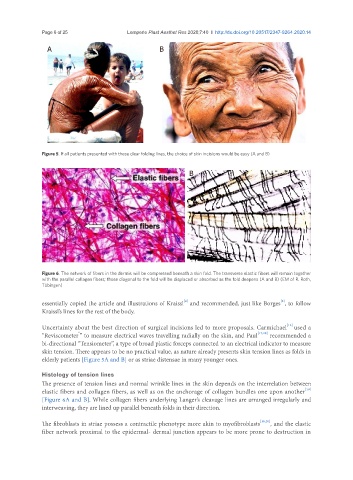Page 437 - Read Online
P. 437
Page 6 of 25 Lemperle Plast Aesthet Res 2020;7:40 I http://dx.doi.org/10.20517/2347-9264.2020.14
A B
Figure 5. If all patients presented with these clear folding lines, the choice of skin incisions would be easy (A and B)
A B
Figure 6. The network of fibers in the dermis will be compressed beneath a skin fold. The transverse elastic fibers will remain together
with the parallel collagen fibers; those diagonal to the fold will be displaced or absorbed as the fold deepens (A and B) (EM of R. Roth,
Tübingen)
[4]
[8]
essentially copied the article and illustrations of Kraissl and recommended, just like Borges , to follow
Kraissl’s lines for the rest of the body.
[13]
Uncertainty about the best direction of surgical incisions led to more proposals. Carmichael used a
®
“Reviscometer ” to measure electrical waves travelling radially on the skin, and Paul [17,18] recommended a
bi-directional “Tensiometer”, a type of broad plastic forceps connected to an electrical indicator to measure
skin tension. There appears to be no practical value, as nature already presents skin tension lines as folds in
elderly patients [Figure 5A and B] or as striae distensae in many younger ones.
Histology of tension lines
The presence of tension lines and normal wrinkle lines in the skin depends on the interrelation between
elastic fibers and collagen fibers, as well as on the anchorage of collagen bundles one upon another
[19]
[Figure 6A and B]. While collagen fibers underlying Langer’s cleavage lines are arranged irregularly and
interweaving, they are lined up parallel beneath folds in their direction.
The fibroblasts in striae possess a contractile phenotype more akin to myofibroblasts [19,20] , and the elastic
fiber network proximal to the epidermal- dermal junction appears to be more prone to destruction in

